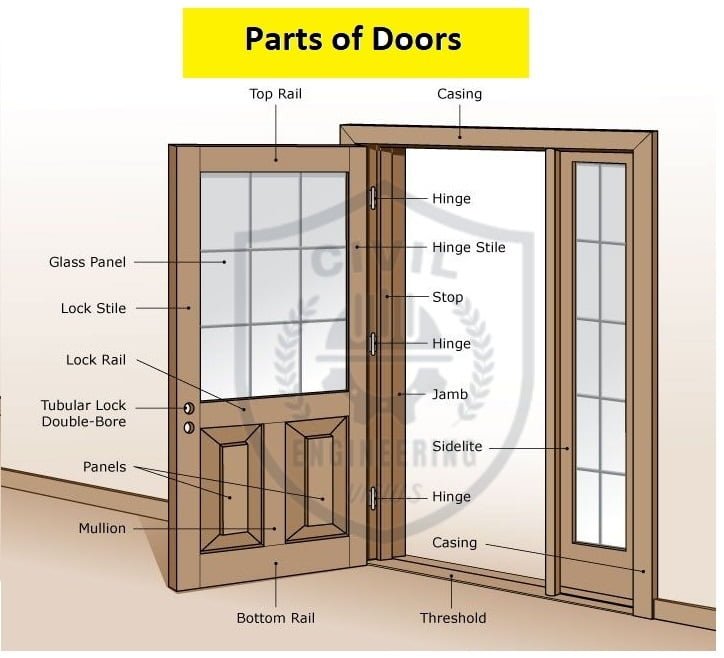Introduction |Function |Location |Methods of Fixing And Parts of Doors
Doors are the passages made to enter the rooms. Paths designed to allow fresh air and light into rooms are called windows. Ventilators are used for ventilation. Doors, windows, and skylights should be in the right place to get the most benefits of them. They are made of different designs and different materials. Introduction of Doors| Function of Doors | Location of Door |Parts of Doors.Introduction |Function |Location |Methods of Fixing And Parts of Doors
Introduction |Function |Location |Methods of Fixing And Parts of Doors
Introduction:
Doors are the passages made to enter the rooms. Paths designed to allow fresh air and light into rooms are called windows. Ventilators are used for ventilation. Doors, windows, and skylights should be in the right place to get the most benefits of them. They are made of different designs and different materials. Designs and materials are chosen according to the type of building, construction cost, and situation. Doors and windows have basically two parts. One of them is called Frame and the other is called Shutter or Leaf. The frame consists of three parts. Which are Head, Sill, and Post. Similarly, a shutter consists of three parts. Which are style, rails, and panels. Glazed-type doors and windows use glass. While the shutters of flush-type doors look plain. Depending on the material, these windows and doors can be made of wood, steel, aluminum, and plastic. The skylights can be hinged or pivoted.
Function of Doors
The purpose of installing doors in any building is as follows:
1. Easily enter and exit the room.
2. Protecting the people living in the building.
3. Introduce fresh air and natural light into the building.
4. Establishing privacy between different rooms of the building.

Location of Doors
To ensure free movement in buildings, a suitable location should be chosen to open the doors. In addition, fresh air intake and privacy should be kept in mind. The following points should be kept in mind for these purposes:
1. The door should be placed at a distance of 20 cm from the corner of the room.
2. Doors and windows should be facing each other for air to flow freely. (cross ventilation
3. The location of the door should be chosen keeping in mind the u of the room. For example, the space of the beds in the bedroom should be taken into consideration and the table and chairs in the dining room should be taken into consideration.
Methods of Fixing
Before attaching the wooden door to the wall, a priming coat of paint should be applied and two hot coats of coal tar should be applied to the part which is attached to the wall. To hold the door firmly in the wall, the edges of the door frame’s sill and head are extended, which is called the door horn. In addition, hold fasts are installed for strength. Hold Fast is actually a flat iron frame, four centimeters in width, half a centimeter in thickness, and a total length of 30 centimeters. At least two holdfasts should be placed on either side of the door. Nails are used to attach them to the door. Level or plumb bob is used to keep the door vertically attached to the wall Two bamboos support the door before masonry, holding the door in a vertical position.
Parts of Door
The doors used in the building have the following parts:

Frame:
The arrangement that covers the shutters of doors, windows, and skylights is called a frame. Which is made of wood, steel or aluminum, etc. Which is usually rectangular in shape. But other than that, it can be made in any shape keeping in mind the beauty.
Head:
The upper horizontal part of the door or window frame is called the head.
Sill:
The lower horizontal part of the door or window frame is called the sill.
Post:
The vertical sides of a door or window frame are called the post of the frame.
Shutter:
An arrangement that closes the inside of a door or window frame is called a shutter. It is made of different materials and hence the name of the door or window.
Styles:
The vertical strips of the shutter are called styles. The style that is captured and attached to the frame is called the Hinged Style of the Shatter, while the other style is called the Meeting Style.
Top Rail:
In the structure of a shutter, the top horizontal strip is called the top rail.
Lock Rail:
A horizontal strip in the structure of a shutter of doors or windows with a lock on it is called a lock rail.
Bottom Rail:
The lowest horizontal strip in the structure of a shutter of doors or windows is called the Bottom Rail.
Frieze Rail:
In addition to the top, bottom, and lock rails in the structure of the shutter of doors or windows, the strip used horizontally is called Frieze Rail.
Sash bar:
The light frame used to attach glass to doors or windows is called a sash bar. They can be vertical or horizontal.
Panel:
A piece of wood or any other material used to fill the space between rails and styles in a door or window shutter is called a panel.
Rebate:
The groove dug around the door or window frame to attach the shutter is called the rebate.
Horns:
The head and sill of the frame extended beyond the width of the door or window are called horns. They help to attach the door or window to the wall well.
Louver:
The pieces of wood or other material placed obliquely or horizontally in the shutter of doors or windows are called louver. While maintaining the quality of privacy, these louvers are helpful in the ventilation of air and light.
Transom:
The horizontal member that differentiates between a door or a window and a fan light is called a transom.
Mullion:
The vertical member that divides a door or window into several parts is called a mullion.
Jamb:
The vertical sides of a wall in which a door or window is placed are called the jamb.
Reveal:
The part of the wall that remains outside the door or window is called the Reveal.
Stops:
The pieces of wood placed at the back of a post to prevent a door or window shutter from hitting a wall when fully open are called stops.
Chocks:
Pieces of wood attached to the front of the post with hinges to prevent the door or window shutter from closing are called chocks.
Hold Fast:
A piece of iron placed outside a post to attach a door or window frame to a wall is called a hold fast.











